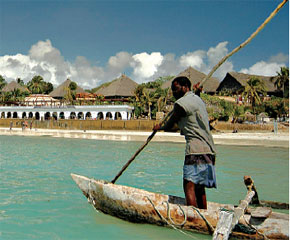Kenya is like a moody woman: hot and sultry one minute, cool and serene the next. It’s a land of deep contrasts, but always pulsating with a vibrant heat.
Jambo! Jambo!
It’s Swahili for hello, and can be heard everywhere
in Kenya. After a long flight, this word sounds sweet – especially when it’s accompanied by an icy juice and a cool terry cloth on a wooden tray. Relief sets in as a tall
man waits patiently while you try to wipe away the effects of the sweltering Mombasa heat. A flash of white teeth and a ‘hakuna matata (no problem)’ later, you’re on your way to
your hotel room before having a seafood dinner overlooking
Diani Beach.
Mombasa is a seafood lover’s nirvana. Crabs, prawns and grilled lobster are as common there as biltong, braaivleis and boerewors in South Africa. For those not inclined to dig into fishy delights, grilled chicken, pasta, roasted vegetables and beef are also on offer.
As everywhere else in Kenya, sesame seed balls and fresh juice accompany watermelon, granadilla and coconuts.
Seaside capers
A day-long trip to Wasini Island takes you sailing with dolphins, snorkelling among coral reefs, and sidestepping goats and geese to get to a coral garden the size of Newlands stadium. The island is an hour away from Shimoni in southern Mombasa and can be reached by dhow only.
Getting to the island is an adventure, but being there is even better. Having lunch in a restaurant that has no floor (unless you count beach sand as a floor) and having bats hanging from the rafters… ‘Don’t worry – they never come down during the day’ are only the beginning of a memorable lunch. Especially when it’s accompanied by the words ‘Enjoy your lunch.’ The hammer, is for crushing crabs the size of saucers. It’s an excellent way to the succulent crab meat inside.
A trip through the village on the island can be both hilarious and sombre. The people are very poor but friendly. The children often break out in song, but the only clear words are ‘jambo’ and ‘hakuna matata’. Called the Swahili people, the population of the island is a mixture of Kenyans and Arabs, none of whom belong to any of the 42 tribes of Kenya. The inhabitants here make up a large part of Kenya’s 30 percent Muslim population.
Bush babyfont
The Tsavo National Park is the biggest of the 27 national parks in Kenya. The park is divided into two parts, Tsavo East and Tsavo West, but it is the former that hosts Satao Camp. The camp is made up of luxury tents overlooking a large bush area. Here you can have your meals while a variety of birdlife, baboon and antelope have theirs about five metres away.
Something old, something new…
For a heavy culture injection, a trip through Old Town in Mombasa is a must. Standing in Fort Jesus, a building constructed in 1593, is slightly eerie, but not as eerie as hearing why the baobab trees sprawled all over the place are grouped together. Every time a soldier died, a baobab seed was thrown on his grave. So, when you see a towering old baobab tree, there might just be a 300-year-old soul lying somewhere beneath it.
On the outskirts of town lies another world. Here the Kariau Akamba tribe creates intricate art from an uninspiring block of wood. They are the only tribe in Kenya that does wood carvings, and it is their sole source of income. Their workshops are dark and musty, but the pieces that come out of the shadows are beautifully
crafted. It is on the city tour some of the buildings look charming and charismatic while others just look dilapidated.
But everywhere you go, people are usually friendlier when they hear you’re from South Africa because it’s the home of ‘that great man Nelson Mandela, heh? That great man – the father of Africa.’ And you instantly become cool by association.

